Lexar has continued to expand its SSD offerings, rolling out the Lexar NM620 SSD. The NM620 is an M.2 SSD that leverages the PCIe Gen3 interface. The drive is billed as being an intensive drive aimed at design, video editing, and gaming. Really though, anything that’s Gen3 these days should be considered entry or mainstream as more demanding workloads have moved onto newer platforms that support Gen4 SSDs.
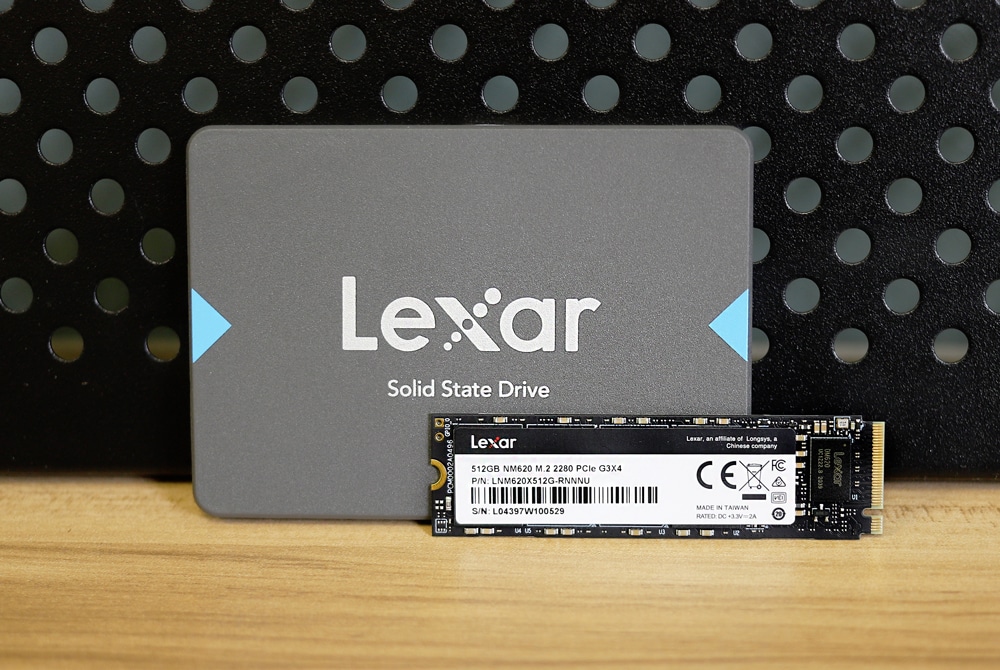
Lexar NM620 Highlights
The company claims that the Lexar NM620 can hit speeds up to 3.3GB/s and throughput up to 300K IOPS. The drive uses Lexar 3D NAND and a Lexar controller, the DM620. The NM620 supports the NVMe 1.4 technology standard as well as LDPC for added reliability. Aside from that, Lexar doesn’t really go into much detail about the drive other than it is much faster than spinning disks.
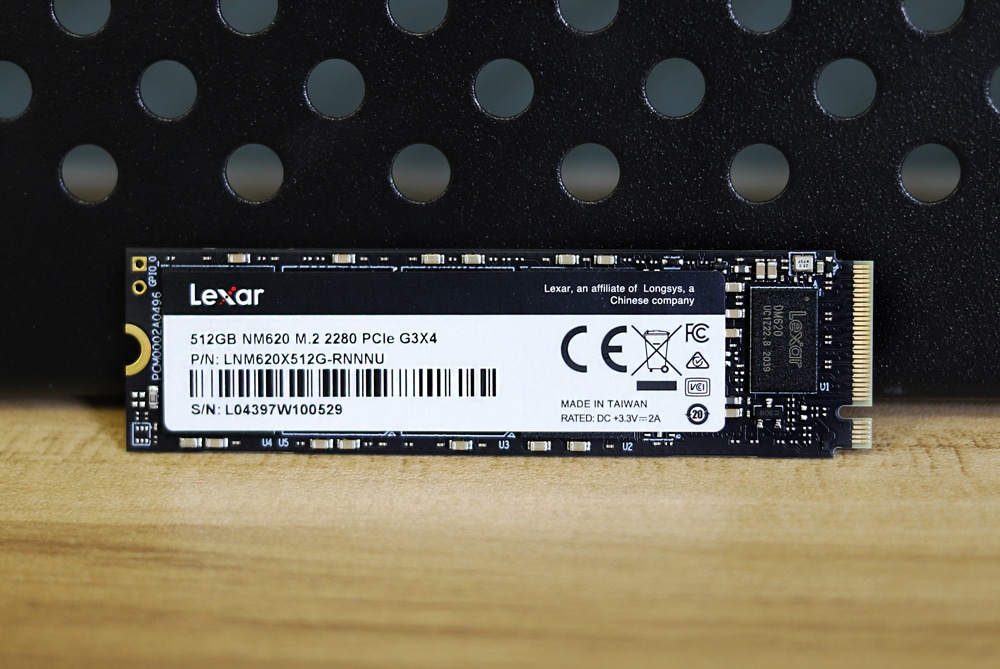
The Lexar NM620 comes with a 5-year limited warranty and in three capacities: 256GB, 512GB, and 1TB. The 512GB can be picked up for $66 and the 1TB can be picked up for $120 (the 256GB was out of stock at the time of this writing). For this review, we are looking at the 512GB version.
Lexar NM620 Specifications
| Capacity | 256GB, 512GB, 1TB |
| Form Factor | M.2 2280 |
| Interface | PCIe Gen3x4 |
| Speed | · 256GB sequential read up to 3000MB/s read, sequential write up to 1300MB/s IOPS: up to 92/240K· 512GB sequential read up to 3300MB/s read, sequential write up to 2400MB/s IOPS: up to 200/256K· 1TB sequential read up to 3300MB/s read, sequential write up to 3000MB/s IOPS: up to 300/256K |
| NAND flash | 3D TLC |
| Operating Temperature | 0° C to 70° C (32°F to 158°F) |
| Storage Temperature | -40° C to 85° C (-40°F to 185°F) |
| Shock Resistant | 1500G, duration 0.5ms, Half Sine Wave |
| Vibration Resistant | 10~2000Hz, 1.5mm, 20G, 1 Oct/min, 30min/axis(X,Y,Z) |
| TBW | 256GB: 125TB, 512GB: 250TB, 1TB: 500TB |
| DWPD | 0.44 |
| MTBF | 1,500,000 Hours |
| Dimension (L x W x H) | 80 mm x 22 mm x 2.25 mm / 3.15” x 0.87” x 0.09” |
| Weight | 9 g |
Lexar NM620 Performance
Testbed
The test platform leveraged in these tests is a Dell PowerEdge R740xd server. We measure SATA performance through a Dell H730P RAID card inside this server, although we set the card in HBA mode only to disable the impact of the RAID card cache. NVMe is tested natively through an M.2 to PCIe adapter card. The methodology used better reflects end-user workflow with the consistency, scalability, and flexibility testing within virtualized server offers.
A large focus is put on drive latency across the entire load range of the drive, not just at the smallest QD1 (Queue-Depth 1) levels. We do this because many of the common consumer benchmarks don’t adequately capture end-user workload profiles.
Houdini by SideFX
The Houdini test is specifically designed to evaluate storage performance as it relates to CGI rendering. The testbed for this application is a variant of the core Dell PowerEdge R740xd server type we use in the lab with dual Intel 6130 CPUs and 64GB DRAM. In this case, we installed Ubuntu Desktop (ubuntu-16.04.3-desktop-amd64) running bare metal. The output of the benchmark is measured in seconds to complete, with fewer being better.
The Maelstrom demo represents a section of the rendering pipeline that highlights the performance capabilities of storage by demonstrating its ability to effectively use the swap file as a form of extended memory. The test does not write out the result data or process the points in order to isolate the wall-time effect of the latency impact to the underlying storage component. The test itself is composed of five phases, three of which we run as part of the benchmark, which is as follows:
- Loads packed points from disk. This is the time to read from the disk. This is single-threaded, which may limit overall throughput.
- Unpacks the points into a single flat array in order to allow them to be processed. If the points do not have a dependency on other points, the working set could be adjusted to stay in-core. This step is multi-threaded.
- (Not Run) Processes the points.
- Repacks them into bucketed blocks suitable for storing back to disk. This step is multi-threaded.
- (Not Run) Writes the bucketed blocks back out to disk.
Here, we see the Lexar NM620 hit 3,577.65 seconds near the bottom of the pack of drives we looked at.
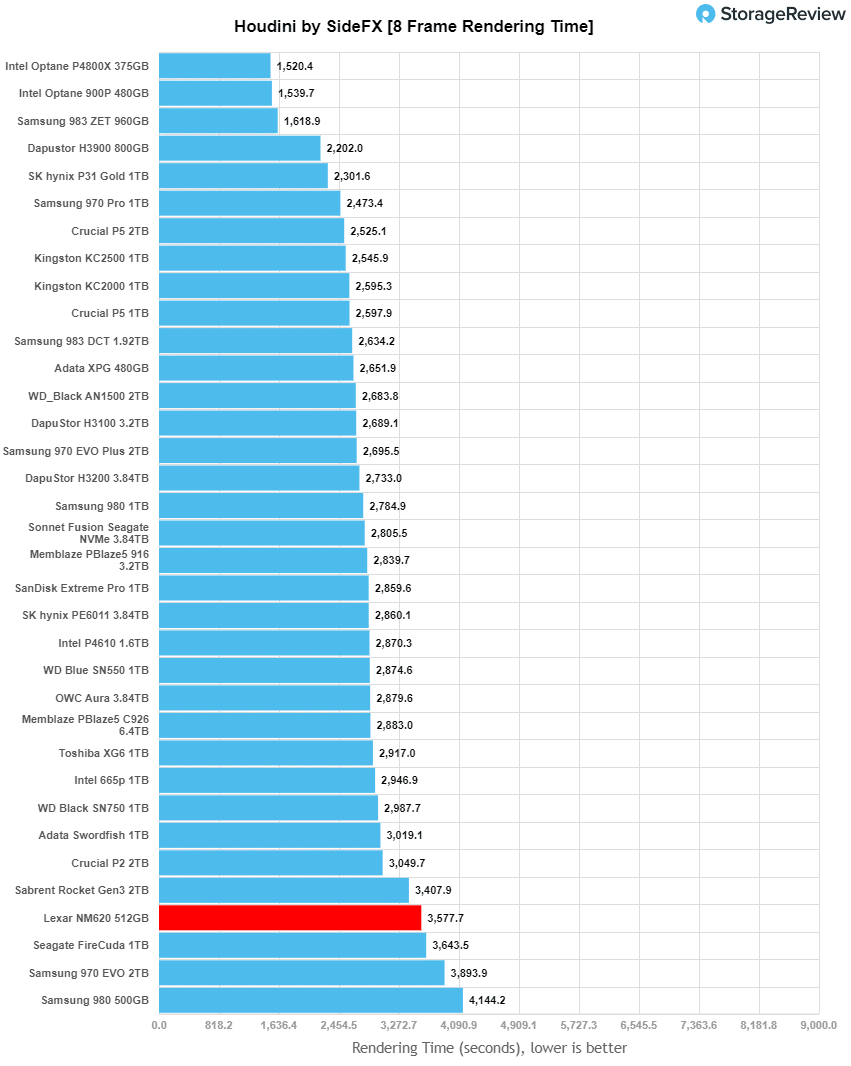
VDBench Workload Analysis
When it comes to benchmarking storage devices, application testing is best, and synthetic testing comes in second place. While not a perfect representation of actual workloads, synthetic tests do help to baseline storage devices with a repeatability factor that makes it easy to do apples-to-apples comparison between competing solutions. These workloads offer a range of different testing profiles ranging from “four corners” tests, common database transfer size tests, to trace captures from different VDI environments.
All of these tests leverage the common vdBench workload generator, with a scripting engine to automate and capture results over a large compute testing cluster. This allows us to repeat the same workloads across a wide range of storage devices, including flash arrays and individual storage devices. Our testing process for these benchmarks fills the entire drive surface with data, then partitions a drive section equal to 5% of the drive capacity to simulate how the drive might respond to application workloads. This is different than full entropy tests which use 100% of the drive and take them into a steady state. As a result, these figures will reflect higher-sustained write speeds.
Profiles:
- 4K Random Read: 100% Read, 128 threads, 0-120% iorate
- 4K Random Write: 100% Write, 64 threads, 0-120% iorate
- 64K Sequential Read: 100% Read, 16 threads, 0-120% iorate
- 64K Sequential Write: 100% Write, 8 threads, 0-120% iorate
Comparables for this review:
First up is random 4K read. Here the Lexar NM620 was dead last with a peak performance of 82,871 IOPS and a latency of 1.52ms.
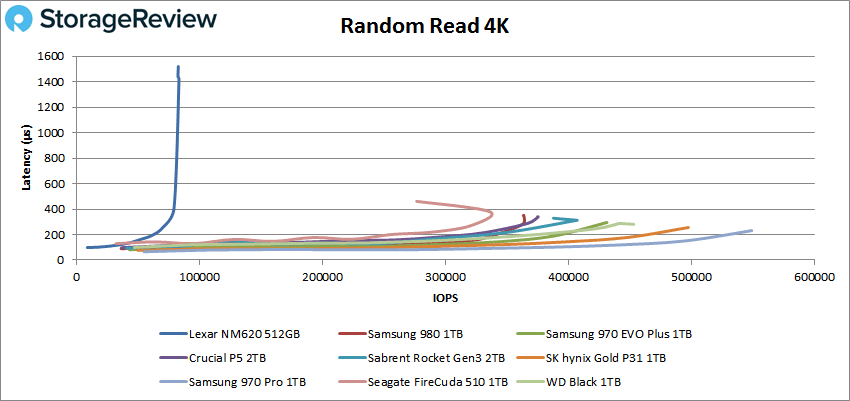
For 4K write the Lexar stayed in last with a peak of 18,880 IOPS and a latency of 4.8ms.
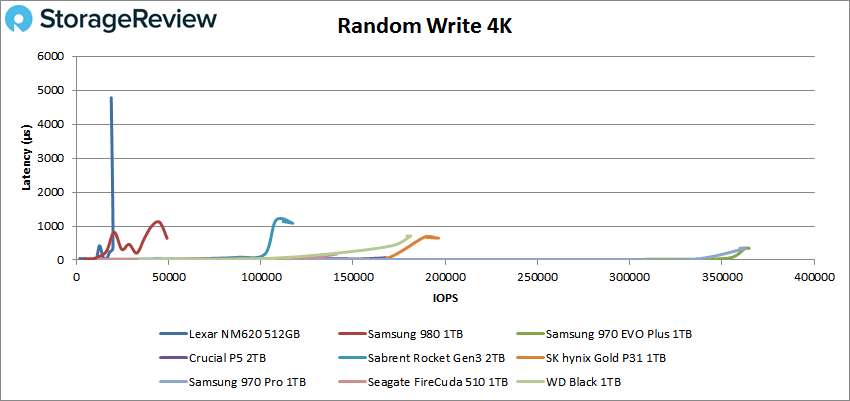
Switching over to our 64K sequential workloads, in read the NM620 came in eighth out of nine with a peak of 26,764 IOPS or 1.7GB/s at a latency of 572µs.
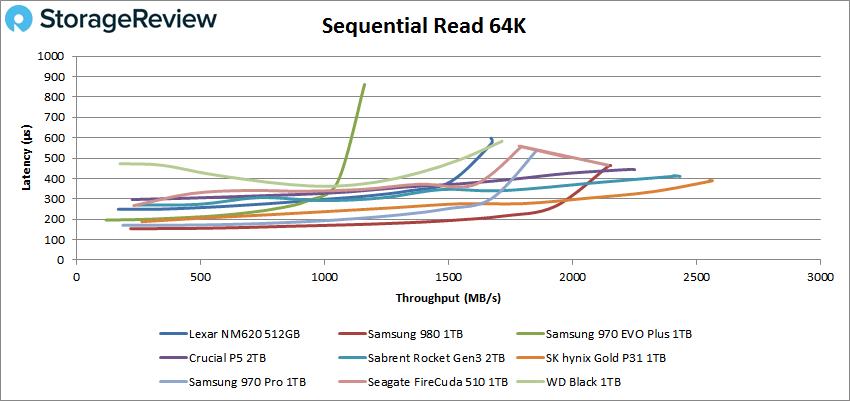
In 64K write, the drive went back to the bottom of the barrel with a peak of 3,243 IOPS or 202MB/s at a latency of 3.14ms.
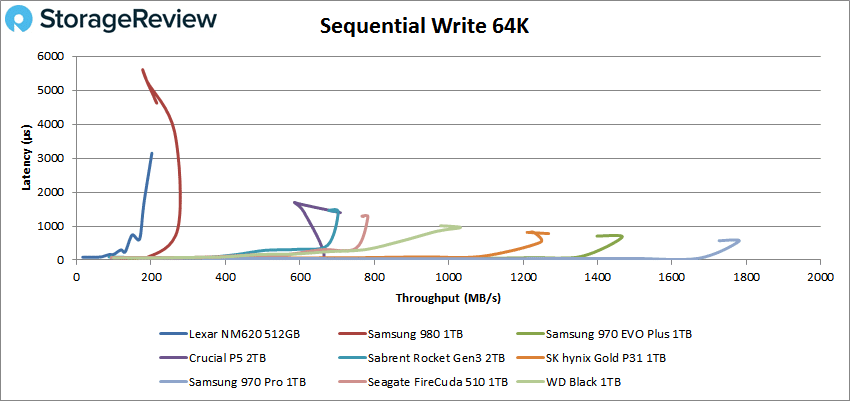
Next, we looked at our VDI benchmarks, which are designed to tax the drives even further. Here you can obviously see that all of these drives struggled, though this was expected due to their focus on price point and read performance only. These tests include Boot, Initial Login, and Monday Login. That said, the Boot test showed the Lexar NM620 in last with a peak of about 25K IOPS at 1.25ms before dropping off some.
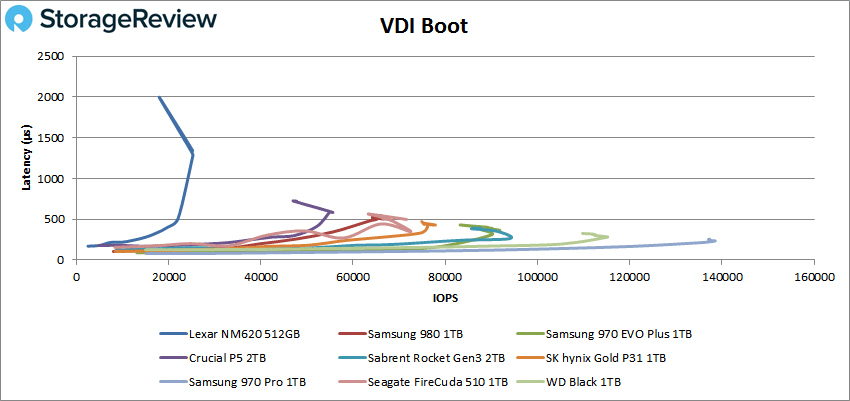
VDI Initial Login had the NM620 place last again with a peak of 7,843 IOPS and a latency of 3.8ms.
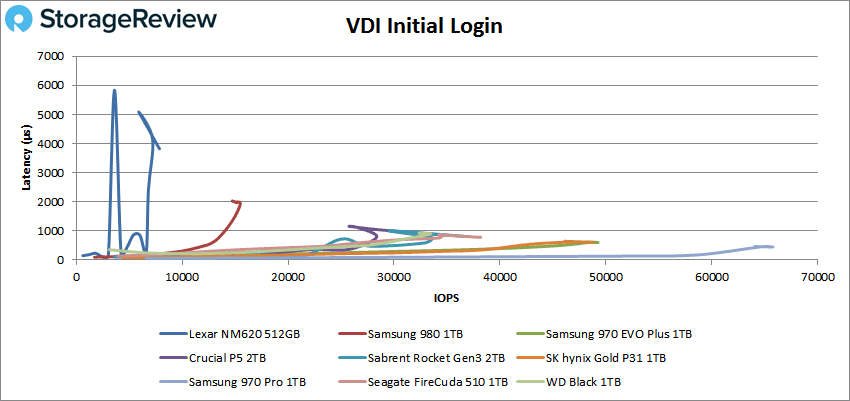
Finally, VDI Monday Login saw the Lexar drive land in last with a peak of 8,402 IOPS and a latency of 1.9ms.
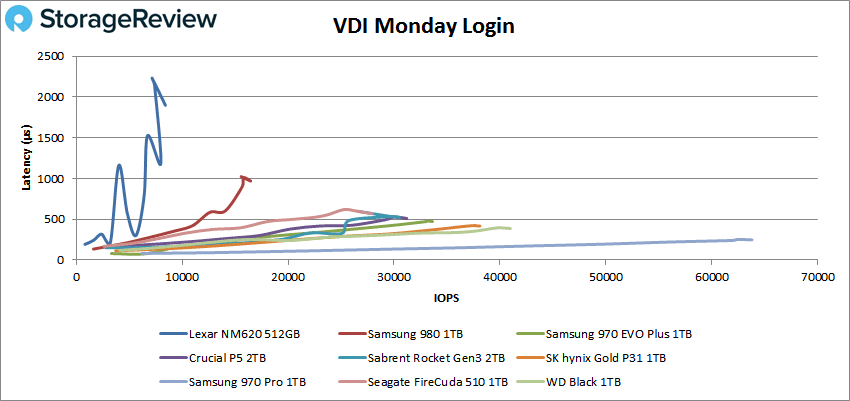
Conclusion
The Lexar NM620 is the company’s latest M.2 SSD. The drive leverages the PCIe Gen3 (NVMe 1.4) interface to bring speeds up to 3.3GB/s and 300K IOPS, in theory. The drive uses in-house NAND and controller as well as LDPC for added reliability. The NM620 is marketed as an intensive drive for design, video editing, and gaming, though it probably shouldn’t be used in those cases.
For performance, we ran Houdini by SFX and VDBench. The Lexar NM620 was in last in every test but one, where it was second to last. And it wasn’t last but just a bit but by quite a large margin. In Houdini, it rendered in 3,577.7 seconds placing it near the bottom. Peak VDBench scores include 83K IOPS in 4K read, 19K IOPS in 4K write, 1.7GB/s in 64K read, and 202MB/s in 64K write. In our VDI tests, the drive hit 25K IOPS in boot, 7,843 IOPS in Initial Login, and 8,402 in Monday Login.
The Lexar NM620 is marketed toward intensive uses but its performance doesn’t back that up in the least. If performance is what you are after there are lots of better choices. If the NM620 comes down in price it would probably be fine for day-to-day use, but that is already a crowded market with lots of options.




 Amazon
Amazon